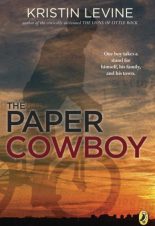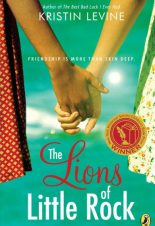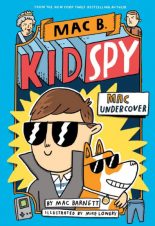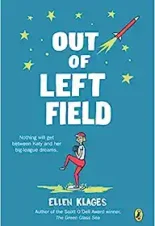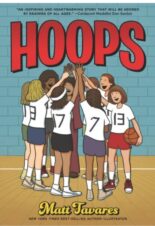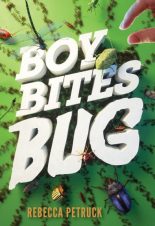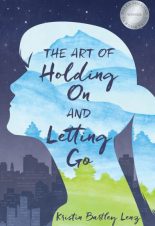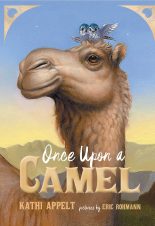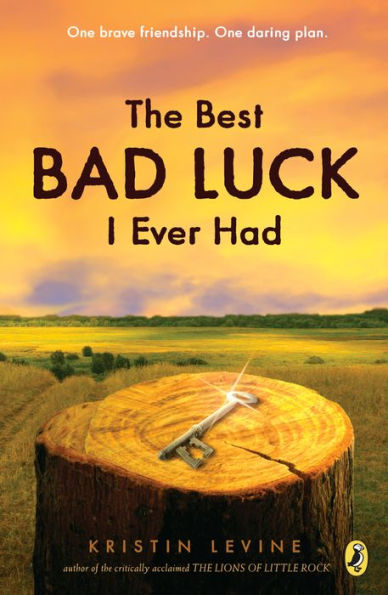
Buy This Book
“An Indian, a Negra and a white boy sitting down to share some chicken and an apple pie. Sounds like a pretty good Thanksgiving to me,” Jim Dang-It. –The Best Bad Luck I Ever Had
The Best Bad Luck I Ever Had
by Kristin Levine
AR Test
10+
Score
4.2
288
Dit is looking forward to the new postmaster’s arrival. Dit was told that the new postmaster would have a son his age. But when the postmaster and his family arrive, everyone is surprised that he’s black. Dit is also upset that the postmaster has a daughter, not a son. Dit has no desire to be friends with Emma, a well-educated girl.
Dit’s mother has a rule. “We didn’t have to like anyone, but we had to be nice to everyone.” Dit’s mother orders him to show Emma around. At first, Dit doesn’t like Emma. She doesn’t play baseball, fish, or climb. She’s smart and talks properly. But Emma is also the first person to ever listen to Dit, and in a house with ten children, that’s important.
Emma forces Dit to think about the difference between the colored kids and the white kids. Then when the town barber, Doc Hadley, is accused of murder and sentenced to be hanged, Dit is faced with an ugly truth. A white man’s word will always be believed, even if it is not true. Dit and Emma know Doc Hadley doesn’t deserve to be punished, so they come up with a daring plan to save Doc from the unthinkable. But if they are caught, the consequences could be disastrous.
Set in 1917 in Moundville, Alabama, and inspired by the author’s family history, The Best Bad Luck I Ever Had takes a look at race relations. The story is told through Dit’s perspective, which allows the reader to see Dit’s personal growth as he comes to understand the inequalities between blacks and whites. Because of Dit’s growing friendship with Emma, he is targeted by bullying. Soon, Dit is faced with a terrible decision—doing what is right or closing his eyes to injustice.
While the story is full of interesting characters, Dit is the only character who is well-developed. Even though the friendship between Dit and Emma is wonderful, a hint of romance at the end is far-fetched. Much like To Kill A Mockingbird, a man is unjustly sentenced to hang. However, this subplot was not fully explored, limiting the emotional impact of the story. Even though Dit is a compelling narrator, the story has several scenes that do nothing to advance the plot but instead make the story drag.
The Best Bad Luck I Ever Had explores the time period between the end of slavery and the beginning of the civil rights movement. The main lesson that readers will take away is, “Some things are worth fighting for. . . You want to do something for this town? Next time you see an injustice, take a stand. It’s worth the risk.”
This coming-of-age journey allows readers to learn positive lessons about social justice, making mistakes, and friendship. While many of the events in the story are predictable, teens will enjoy the surprising conclusion. Unlike Levine’s book The Lions of Little Rock, The Best Bad Luck I Ever Had doesn’t have much of an emotional impact. The Best Bad Luck I Ever Had imparts important life lessons, but the slow pacing will make it hard for some readers to stay engaged. Readers who want to explore racial relations during the 1900s should read To Kill a Mockingbird by Harper Lee. I’m Not Dying with You Tonight by Kimberly Jones & Gilly Segal also explores racial inequality, and how it still exists today.
Sexual Content
- Several times, Dit’s friends tease him about kissing Emma. For example, when they see him talking to her, “Chip snickered and made kissing sounds.”
- Dit tells his friends that he hasn’t seen Emma. Chip replies, “Course you ain’t. ‘Cause you got your eyes closed when you’re kissing her.”
- A black boy’s grandfather was white. The boy explains, “My grandpa was a white man, a big plantation owner. Took my grandma out in the woods and nine months later she had my pa.”
- Dit and Emma hear noises in the barn. “It sounded like two people, whispering and laughing. . . there, sitting on a bale of hay, was my oldest sister, Della. And she was kissing Mr. Fulton’s oldest boy.”
- Emma tells Dit, “You’re the best friend I’ve ever had.” Then she kisses him on the cheek. Later, Dit kisses her on the cheek. They kiss on the cheek three times in total.
- Emma and her parents are moving. As Emma and Dit say goodbye, he asks her, “Can I kiss you goodbye?” After getting permission, Dit kissed her “right on the lips and everything. I probably should say it was gross or something. But it was actually kind of nice.”
- The town has a different cemetery for “fallen women.”
- Dit asks his dad, “Are you ever gonna give me the talk?” His father replies, “The part about girls, it’s just too embarrassing. Ask Raymond.”
Violence
- Dit uses a flip-it to kill a bird. “The bird was stretching out its neck for another ant. When the rock hit it, the yellowhammer fell to the ground.” Dit feeds the bird to a caged eagle.
- Dit shoots a buzzard out of the sky. “The bird jumped up and let out a terrible scream.”
- When someone calls Dit a “nigger lover,” Dit “slugged him. Hit him right in the nose. He staggered but didn’t fall over, so I punched him in the stomach.” Several kids break up the fight.
- In the past, the sheriff killed a man “in a bar fight. Claimed it was an accident, but everyone knew it wasn’t.”
- A woman paid Dit to throw a bag of kittens into the river. Dit “closed my eyes and with a deep breath hurled the sack up over my head and into the water. Took off running before I even heard the splash.” Later, Dit and Emma go to the river and find the sack with the kittens still alive.
- Someone tells Dit about a man who died and that “He lay perfectly still with his eyes wide open.”
- Emma’s mother tells her, “Your great-grandmother used to get up before sunrise and work in the fields all day without a rest. If she didn’t work fast enough, she was whipped until the blood ran down her back.”
- Two of Dit’s friends lock him in a prison cell. They want him to “admit you love that nigger girl.” When they let Dit out of the cell, his “fist hit Chip square in the jaw. He fell to the ground.”
- Someone makes a reference to “the poor Negro who was lynched in Jefferson County last month.”
- When Emma was practicing for the school play, Big Foot comes into the schoolhouse to kick her out. He tells her to leave. When she doesn’t he “picked up Emma and threw her over his shoulder like I’d seen my pa do with a sack of potatoes. . .” A black man named Doc tells Big Foot to put Emma down. “Big Foot dropped her then. Just let go of Emma’s feet and she slid right down his back. Her head made a loud thwack as it hit the floor. . . Blood was pouring out of a gash on her forehead.” Emma’s wound needs stitches.
- When Doc stands up to Big Foot, “Big Foot punched him in the jaw. Doc staggered but remained upright. Big Foot slugged him again. Doc fell to the ground this time. Blood flowed from his lip to his chin. . . Big Foot charged Doc Hadley then, ran at him like a crazed bull. . . We could hear punches being thrown and then there was a crack of something like a broken bone.” Doc Hadley is knocked unconscious and has several wounds. The scene is described over three pages.
- Later, Doc Hadley’s wounds are described. “Doc Hadley was hurt bad. His left arm was broken; he had two black eyes, a split lip, a twisted ankle, a couple of bruised ribs and a lump on his head the size of an old twine baseball.”
- Big Foot goes into Doc Hadley’s barbershop.” Big Foot “punched him in the stomach. Doc doubled over in pain and Big Foot hit him again, knocking him to the ground.” Both men pull a gun. Big Foot yells, “Get up off the floor so I can shoot you like a man!”
- Big Foot shoots his gun. “Big Foot approached the barber chair, his boots crunching on broken glass. He was too close to miss now, and his finger was on the trigger. Doc aimed for Big Foot’s leg, but the sheriff spun the chair around, hitting Doc’s arm. Both pistols went off at once. The sheriff gasped and fell to the ground, twitching wildly.” Big Foot dies. The scene is described over three pages.
- Big Foot’s mother talks about the past. “But he was always a violent boy. Got in fights at school, tortured stray dogs around town. . . He only got worse as he got older, drinking and brawling in bars. Then there was that man in Selma. I knew it wasn’t no accident.”
- Dit and Emma come up with a plan to free Doc Hadley from jail. In order to get blood for their plan, Dit catches a rabbit. “It quivered in fear, its dark eyes huge in the candlelight. . . .With a snap, I broke the rabbit’s neck. It twitched for a moment, then hung limp as an old hat, warm in my hands.” Dit feels guilty about killing the rabbit.
Drugs and Alcohol
- After Big Foot beats up Doc Hadley, “Big Foot didn’t leave his front porch for that whole week, just sat there and drank beer.”
- An old man walks around town. He thinks he is sleepwalking. He tells Dit, “My daughter warned me about drinking a whole bottle of whiskey in one sitting.”
Language
- When a new postmaster and his family move to town, they are referred to as “niggers” ten times. For example, someone says, “Only one school around here for a nigger. And if you ask me, that’s one too many.”
- Someone tells Dit, “I think it’s terrible that a nice boy like you runs around with a nigger.”
- Several times, someone calls Dit a “nigger lover.”
- When a plane lands in a field, someone exclaims, “Jesus, Joseph and General Lee.”
- When assigning parts for the school play, the teacher asks a boy to be the ringmaster. The boy refuses because “I don’t want to be no Chinaman with slitty eyes!”
- A boy calls Emma an egghead.
- Attempting to stop a fight, Emma throws hot grease on Big Foot. He yells, “Goddamn it!”
- When the mayor discovers that someone killed himself, he says, “Oh my God!”
Supernatural
- None
Spiritual Content
- Dit and Emma find an old pottery bowl with a drawing on it. Someone tells them, “This bowl was used by the Indians. When someone died, they filled it with water and placed it in the fire so their loved ones would not go thirsty on their journey to the underworld. The hand and the eye stand for the God who made everything and the God who sees everything.”
- When a man tells Dit about his dead wife, Dit’s “lips moved briefly in a silent prayer.” Later the man tells Dit that he was, “angry at God for taking her away.”
- After Dit throws a sack of kittens into a river, he feels guilty and goes to church. Dit “folded my hands in prayer and tried not to think about the kittens.” During the service, the reverend says, “Our sermon today is entitled ‘How Long Will Hell Last.’ Those who have been unjust and have inflicted suffering on those smaller and weaker than themselves will burn in hell. . . Those who harm innocent creatures will suffer in hell as surely as those who’ve broken all Ten Commandments.”
- When Dit and Emma find the kittens alive, Dit thinks, “God had worked a miracle in exchange for my dime.”
- Dit goes to church on Christmas Eve. He listens to a sermon about “the Star of Bethlehem and how amazed the shepherds had been when they had seen it.” Dit tries to pay attention because he “didn’t want to accidentally end up going to hell.”
- While driving, a car spins out of control. Dit, “started praying, but the only prayer that came to mind was Jesus, Joseph and General Lee.”
- Doc Hadley’s son wants to see his father’s body. Someone tells him, “Your daddy’s moved on to a better place.” Someone else asks, “He was a suicide. Don’t they go to hell?”
“An Indian, a Negra and a white boy sitting down to share some chicken and an apple pie. Sounds like a pretty good Thanksgiving to me,” Jim Dang-It. –The Best Bad Luck I Ever Had
Latest Reviews

A Tale of Magic

The Immortal Fire

Grace Hopper: Queen of Computer Code

Girls Who Code: Learn to Code and Change the World

Alone

Friends Fur-Ever

Harry Houdini: A Magical Life

The Greedy Gremlin

Hoop Genius: How a Desperate Teacher and a Rowdy Gym Class Invented Basketball

